Ashgabat
Alem Ferris wheel
State Museum
Fine Arts museum
Wedding Palace
Nisa fortress
Memorial Complex
Ertogrul Gazi Mosque
Neutrality monument
Independence Park
Turkmenbashi Ruhy Mosque
Olympic Village
Ylham Alley
Carpet Museum
Monument of Lenin
Ahal Region
Abivert
Altyn Depe
Annau
Darvaza
Geokdepe
Kowata
Mane baba
Zengi baba
Nedir Shah
Nokhur
Parzdepe
Sarahs baba
Seyit Jemaleddin mosque
Shahrislam
Ulug depe
Mary region
40 cupolas
Akcha Kala
Ancient Merv
Badkhyz
Chilburj
Gebeklytepe
Geok Gumbaz
Gurtly Depe
Kharoba Koshuk
Talkhatan Baba
Yekedeshik
Dashoguz region
Ashyk Aydyn Pir
Devkeshen
Ismamit ata
Kalaly-gyr
Kaplankyr Nature Reserve
Kunya-Urgench
Damla
Balkan region
Dehistan
Yangikala
Awaza
Gozli ata
Kemal ata
Mashat ata
Paraw bibi
Lunar Mountains
Shevlan Baba
Igdy kala
Kunya-Urgench is located on the land of ancient Khorezm, 480 km north of the capital of Turkmenistan - Ashgabat, near the old channel of the Amu Darya. Kunya-Urgench was located on one of the most important medieval routes of the Great Silk Road, the crossroads of Western and Eastern civilizations. It is one of the most important archaeological sites in Turkmenistan, located in a vast protected area and containing a large number of well-preserved monuments dating from the 11th-16th centuries. They include mosques, caravanserai gates, fortresses, mausoleums and minaret, and their architectural style and artisanship influence reached Iran, Afghanistan and later architecture of the Mughal Empire in 16th century India.
For a long period, a prosperous school of master builders existed and flourished in Kunya-urgench. The knowledge and skills of the masters of this school for centuries have spread throughout the Muslim world; their creations can be seen on the structures and decoration of many buildings during the reign of Tamerlane, both in Turkmenistan itself and in other countries and regions, such as Uzbekistan, Afghanistan, the South Caucasus, Turkey, Iran, Pakistan and India. For example, builders and architects from Kunya-urgench erected many buildings in Samarkand in the 14th century.
The skill and proficiency of the medieval Turkmen masters and architects of Khorezm can be seen in the study of the structure, forms and patterns of buildings, which have improved over time. Moreover, traditional construction techniques have survived to this day, such as kilns, first used in Köneurgench, are still used throughout the region to produce bricks for the renovation of historic buildings.
The city is mentioned in the sacred book of the Zoroastrians "Avesta" under the name Urva (Urga). In the Kangyui period, it was known as Hangird (Hajird). Alexander Yakubovsky carried out the first archaeological excavations in the old city in 1929. By this time, most of the Kunya-urgench monuments were completely or partially destroyed
The ancient city contains a number of monuments dating mainly from the 11th-16th centuries, including a mosque, caravanserai gates, fortresses, mausoleums and a minaret. They testify to the outstanding achievements in medieval Turkmen architecture and crafts, the influence of which manifested itself in Iran and Afghanistan, and later, in the 16th century, in the architecture of the Mughal Empire in India.
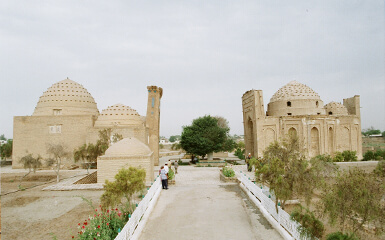
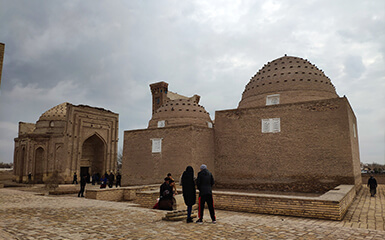
Currently, there are three small mausoleums of the 12th century and a perfect mausoleum of Tyurabek-khanym of the 14th century on the territory of the city, which was almost completely restored in the 1990s.
The mausoleum of Tyurabek-khanym, the mausoleum of the daughter of the Golden Horde khan Uzbek-khan and the wife of his Khorezm governor Kutlug-Timur, which later became the burial vault of the Sufi dynasty of the Kungrats, located in Kunya-Urgench.
Tyurabek-khanym, a real historical figure, daughter of the ruler of the Golden Horde, Uzbek-khan and the spouse of his governor in Khorezm Kutlug-Timur. Turabek-khanym was the patroness of women. Over time, she was canonized and declared a saint. She died young and at the behest of the inconsolable ruler over her grave, the best masters of Khorezm built a palace worthy of her charm. The mausoleum is the tomb of the Sufi dynasty and was built in the 14th century.
The Mausoleum of Tyurabek-khanym has an imposing south facing peshtak, some 25m high. Behind this is a domed lobby, with a spiral staircase to the right. The main chamber beyond is hexagonal in plan, with tall arched niches on each wall. The mosaic on the underside of die dome is stunning, its design apparently involving 365 interlocking geometric figures, one for each day of the year. The inner side of the dome is covered with a mosaic panel of the finest work with an ornament of stars and flowers. The panel is a masterpiece of Khorezm art, which has no analogues in the entire medieval architecture. Above the building on a high drum with twelve openings tower a blue glazed tent.
The mausoleum has come down to us in a very ruined state. The roof leads to a small palace, from which a large six-sided khanaqah. The room has deep arched shelves. The exterior is 12-sided, with deep arches on each side. The pedestal is 24-sided, with a dome (the eastern part is preserved), decorated with elegant tiles and muqarnas. The mausoleum of Tyurabek-khanym is a unique monument that reflects the high artistic mastery of 14th century Khorezm architecture.
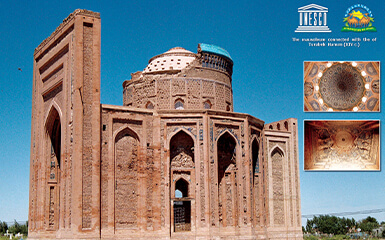
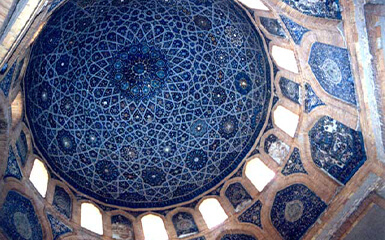
Minaret Kutlug-Timur is a minaret of the XIV century, located in the north of Turkmenistan, on the territory of the ancient settlement of the city of Kunya-Urgench. The height of the minaret reaches 60 meters, according to other sources - 62 meters, and is the tallest minaret and architectural monument in all of Central Asia. For comparison, the height of the second highest minaret in the region, the Islam-Khodja minaret in Khiva, is 56.6 meters, and in third place is the minaret of the Khast-Imam mosque in Tashkent, which is 53 meters high.
The Kutlug-Timur minaret, together with the rest of the architectural, archaeological, religious and cultural sites of the city of Kunya-Urgench, is included in the list of UNESCO World Heritage Sites in Turkmenistan under the name "Kunya-Urgench".
Located on the territory of the historical and cultural reserve "Kunya-Urgench". The ancient mausoleum of Sultan-Tekesh is located near the minaret. The minaret was built in 1320-1330 (it has been standing for almost seven centuries) by a dignitary of the Khan of the Golden Horde. During the construction of this minaret, Kutlug-Timur was then the ruler of the ancient Kunya-Urgench and its environs. According to some reports, Kutlug-Timur only rebuilt or increased the height of the minaret, which existed earlier, and which was built in 1011, during the reign of the State of Khorezmshahs.
The minaret is built of ceramic bricks. The diameter at the base is 12 meters, at the very top it is about two meters, inside there is a spiral staircase of 145 steps. The architecture of the minaret is a vivid example of the school of Khorezm master architects. The minaret narrows sharply towards the top, and has been preserved almost to its entire height. Some inclination of the minaret is especially noticeable in its upper part. It is believed that the reason for this was earthquakes or a fire that caused uneven heating of the masonry. On the minaret, there are inscriptions in Kufic Arabic script, on which the name of Kutlug-Timur is written, as well as the name of Uzbek Khan, the khan of the Golden Horde in 1313-1341, that is, during the construction of this minaret.
In ancient times, a mosque was adjacent to the minaret, and the entrance to the minaret was inside the mosque. This minaret belongs to a group of approximately 60 minarets and towers built between the 11th and 14th centuries in Central Asia, Iran and Afghanistan. A striking example of the similarity and time of construction can be considered the Jam minaret in the territory of present-day Afghanistan.
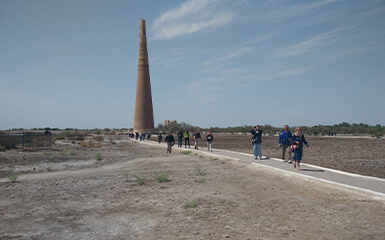
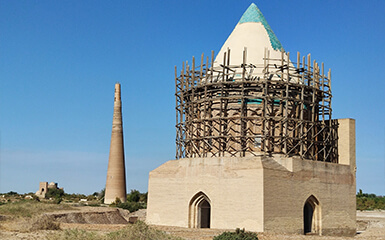
The most famous mausoleum of Koneurgench, primarily among Islamic pilgrims, is the mausoleum of Nadjmeddin al-Kubr (najm ad-din (Arabic) - "Star of religion (faith)") - a Sufi ascetic of the 13th century, who is considered the founder of Sufism in Khorezm.
Born in 540/1145 in Konye-Urgench, Najmuddin Kubra began his career as a scholar of hadith and kalam. His interest in Sufism began in Egypt where he became a murid of Ruzbihan Baqli, who was an initiate of the Uwaisi. After years of study, he abandoned his exploration of the religious sciences and devoted himself entirely to the Sufi way of life.
He was a Muslim mystic and the founder of the Tariqa Kubrawiyya. Its name is probably derived from at-tammat al-kubra (the greatest visitation), based on the Koran sura 79, verse 34; According to the analysis of the orientalist Fritz Meier, this name refers to Kubra's youth and is a nickname for his strong intellectual power. Among the Khorasan Sufis, he received the honorary title: Sheikh-i wali tarash - that is, "the holy carver", since many of his students are said to have achieved a high spiritual rank.
Sufi sheikh Zia al-Din-'Ammar Bitlisi was Kubra's teacher, who tried to present Sufi thought in a new way to provide contemplation and influence for the reader. After receiving his khirka, Kubra gained a large following of gnostics and writers on Sufism.
Nadjmeddin Kubra, the founder of the Kubravid school of Sufism, who was born in Khiva in 1145, and died here at the hands of the Mongols in 1221. The 14th- century mausoleum has a delightful portal, with blue and turquoise tiles in geometric, floral and calligraphic designs. Local guides believe that the outward lean of the portal is not a sign of future collapse, but a deliberate architectural feature, to symbolise the building bowing down in prayer. Nadjmeddin Kubra’s tomb itself is in two parts: the larger for his body, the smaller one for his head, which was separated by the Mongols. The tombs are covered with fine majolica tile-work, but this is covered over by velvet cloths. The mausoleum is a major place of pilgrimage: visitors circle it three times, touching the walls and then their foreheads while reciting prayers, before entering.


The mausoleum of Il-Arslan (Fakhreddin Razi) (Il Arslanyň kümmeti) is the mausoleum of one of the most famous Khorezmshahs Il-Arslan, located in Kunya-Urgench.
This is the oldest surviving building in Urgench, the capital of Khorezm. This mausoleum is one of the first in a long line of monumental buildings in Central Asia, whose height is artificially increased by the space between the inner dome and the outer tent. The first double domes appeared, however, in northern Khorasan in the 11th century, but their inter-dome sinuses were small and were not designed for external effect; the innovation, captured in the small Urgench mausoleum and giving it a resemblance to an obelisk, will later be embodied in the grandiose buildings of Timur and his descendants.
Built over the imaginary grave of Fakhreddin Razi or over the real Khorezmshah Il-Arslan, the mausoleum in Urgench is one of the most outstanding buildings of pre-Mongol Central Asia, combining unique features, technical and artistic, with ideas and images of future, not yet embodied architecture.
The mausoleum is known primarily for the magnificent terracotta decoration of the main facade and dates (by indirect evidence) to the second half of the 12th century. It also has the name "Fakhreddin Razi's mausoleum". The theologian Fakhreddin Razi was buried in Herat in 1208, and the mausoleum in Urgench could not be his tomb; according to V. I. Pilyavsky's hypothesis, this small but spectacular building was erected over the ashes of the Khorezmshah Il-Arslan, who ruled in 1156-1172, the father of the Khorezmshah Tekesh. Based only on the “exceptional architectural and artistic merit” of the building, this hypothesis does not explain why the name of a humble scientist has replaced the name of a powerful ruler in popular memory, if he is really buried here.
The twelve-sided dome of Il-Arslan, decorated with a geometric ornament with blue tiles, is one of the oldest pyramidal-shaped coverings that have survived in Central Asia. The Il-Arslan mausoleum was manually decorated with relief carved terracotta, expressed in intricate ornamentation: floral and geometric patterns.

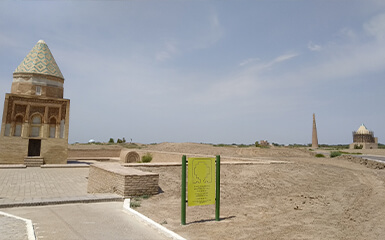
The most ancient structure of the settlement is the fortress "Kyrkmolla" (Forty mullah), on the site of which the so-called "Academy" of Sultan Mamun ibn-Mamun was built in the 11th century, where the encyclopaedist Abu Reikhan al-Biruni and natural scientist, physician and philosopher Abu Ali ibn-Sina also known as Avicenna studied.
To the northeast of the mausoleum Tekesh sands a low hill, covering some 3 hectares and never much more than 12m in height. The hill bears the curious name of Kyrk Molla. Excavations along its western slope have revealed the inclined walls of a fortress, punctuated by square towers. This is believed to be the ancient heart of Gurganj: some finds here have been dated to the 5th century BC. The excavations there revealed a vallum of the ancient period and an altar. Researchers believe that the fortress was destroyed on the arrival of the Arabs in the 8th century. Local legends surrounding the name of the place are based around the 40 mullahs as wise teachers, leading to suggestions that this may have thereafter been the site of an important madrasa. One-tale runs that, with the dreaded Mongols fast approaching, the 40 mullahs prayed that the rare and beautiful books of the Academy be spared. Their prayers were answered by the Academy suddenly turning upside down, so that its doors were underground, out of reach of the Mongols. In addition, this, the tale concludes, is how the hill was formed. The great books remain below ground, waiting to be uncovered.
Kyrk Molla, which was later the site of a cemetery, is one of the most atmospheric places in Konye-Urgench, and an important pilgrimage destination. Pilgrims, mostly by infertile women who have a strange ritual at that place, visit this place. After praying to Allah they wrap in a cloak or a blanket and roll down the hill. They ask the saints to help them this way. Men with their requests also come there to pray on a hilltop. There is a path leading to the site, but a temporary blue barrier fence is at the base of the hill, which prevented access. The western walls of the fortress is restored and the ruins seem beyond the perfectly shaped walls.
